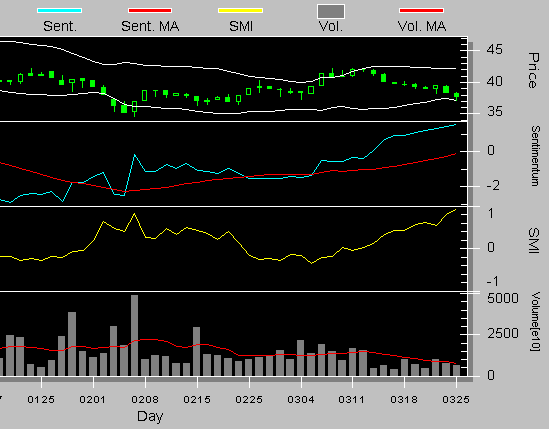 Trend
Line and Breakout Scan Program
Trend
Line and Breakout Scan Program Mark Seifer's Sentimentum Indicator Explanation.

Top Graph: Price with Bollinger Bands
2nd Graph: Sentimentum Line with its' 20 day moving average
3rd Graph: Sentimentum Index Line
Bottom Graph: Daily Volume with its' 10 day moving average
To Chart Sentimentum in the Ramp program: After you have run a sentimentum scan you go to the "Sentimentum" menu item under "Special Scans" and select the bottom item, "Chart Sentimentum".
Sentimentum
combines the principles of momentum and on-balance volume to provide an
advance indication of trend reversals and a measure of overbought / oversold
conditions. It basically measures volume-weighted price movement accumulated
over time. High volume moves cause a corresponding change in sentimentum
while low volume moves produce a reverse effect. Sentimentum doesn't change
when price moves occur at average volume or when there is no price change.
The absolute scale for sentimentum is irrelevant, but the range of the
scale should be at least half the price range over the same time period
for the signals to be reliable.
To help distinguish trends in Sentimentum, a moving average of the SM
line is also plotted. The smoothing period should be chosen so that the
lines for daily sentimentum and its moving average touch as often as possible,
without crossing. The period for volume averaging must also be chosen.
Recommended values are 10 for the volume average and 20 for the smoothing
period, but experimentation is worthwhile.
When looking at the Sentimentum study, note the slope of the line. Rising
Sentimentum values may be an indication of a healthy, sustainable rally
in the market. Also note instances of divergence. That is to say, when
the underlying issue is reaching new highs, if the Sentimentum indicator
is not also acting similarly, then the upward move may be coming to an
end.
Sentimentum Line Trading strategies:
You want
to buy and/or own a stock when its sentimentum is rising. This is because of the underlying implication
that there are more buyers than sellers and the price will ultimately
go higher.
Trading
strategies will differ in their interpretation and application of this
principle. Since sentimentum
tends to fluctuate on a daily basis, if one were to aggressively follow
this principle they would end up trading on a very frequent basis. To smooth out the daily fluctuation and help discern trends
in Sentimentum , the moving average is also plotted. When Sentimentum crosses above or below its moving average
it implies a possible change in the trend. Further confirmation is provided
when the sentimentum moving average itself turns up or down. Any one of
these events can be used as a basis for trading decisions.
Sentimentum Index:
Trading
strategies that only use sentimentum do not account for risk because they
don't take into consideration volatility, support, and resistance.
One way to measure the influence of these variables is with Bollinger
bands, a very popular technical indicator. By combining the relative strength of
Sentimentum with Bollinger bands you get the Sentimentum index which can
also be used in trading strategies.
An index
of 1.0 means the stock price is at the lower Bollinger band and sentimentum
is at a peak for the period (usually 20 days). Conversely an index of
-1.0 means that the stock price is at the upper Bollinger band and Sentimentum
is at its lowest point. The Sentimentum index has been backed tested on
several growth stock portfolios during several time periods and when the
index measured 0.6 or above the corresponding stock price appreciated
at least 10% in less than 1 month more than 65% of the time. That is why
I post stocks from The Spear Report Consensus List with SMI > 0.6 on
a daily basis. I also post stocks with SMI < -0.6 although I suggest
that people sell their long positions before sentimentum and the Sentimentum
index get that low.
There are several points to consider when using the Sentimentum index:
· The
index was designed to compare changes in price and volume.
When these values do not change much during the evaluation
period, sentimentum becomes flat and the index becomes erratic.
A good rule of thumb is that the range of
Sentimentum should be at least half of the range in the stock
price over the period for the signals to be reliable.
· Stocks
that are in a strong upward trend often do not fall below the moving average
and therefore the Sentimentum index will not rise above 0.5. These stocks
may still be worth considering.
· Stocks
that are below the moving average are considered by many to be in a downward
trend and often run into resistance at the moving average.
· When stocks trade near the Bollinger bands the
volume tends to increase causing radical changes in Sentimentum.
Individual Trading strategies should be based on three factors:
·
available time and desired trading frequency
·
risk tolerance
·
size of your portfolio
If more
than 50 percent of your trades are successful then it only makes sense
that you should trade more frequently. The amount of money you gain or
lose on each trade will depend on your risk tolerance. The more diversified your portfolio is
the more consistent will be your returns.
Disclaimer: Nebadawn, Inc. assumes no responsibility for actions taken by any individual using Sentimentum or the Ramp program to make investment decisions. Nebadawn, Inc. employees are not brokers or investment counselors and are not providing investment advice. The use of Nebadawn Inc.'s products implies no claims, promises, or guarantees that any suggestion, system, trading strategy, or information will result in a profit, loss, or any other desired result. All users of Nebadawn Inc.'s products assume all risk, including, but not limited to, the risk of losses.